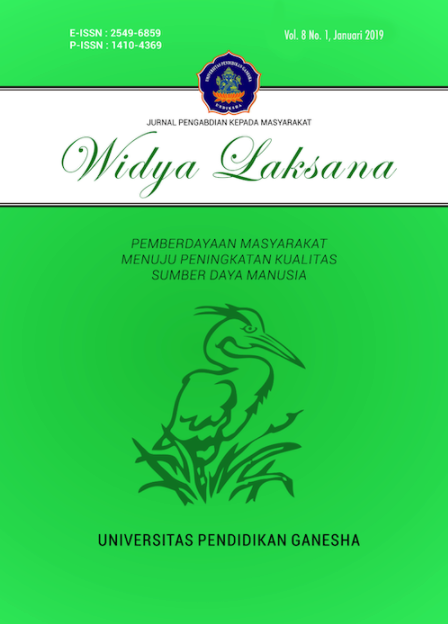PENINGKATAN REGULASI EMOSI MELALUI PROGRAM HARMONY FROM WITHIN PADA REMAJA PANTI ASUHAN NARAYAN SEVA BULELENG-BALI
DOI:
https://doi.org/10.23887/jwl.v11i1.42326Abstract
The psychological training and mentoring entitled “Harmony from Within” aimed at improving emotion regulation strategies of adolescents at the Narayan Seva Orphanage, Buleleng-Bali. Participants were 22 adolescents ranging from 16 to 20 years old. The methods included seminar, discussion, presentation, and group work. Based on the evaluation conducted, it was found this activity was rated very well by the participants. In addition, there were also differences in emotion regulation scores among the two strategies, namely cognitive reappraisal and the expressive suppression before and after training. As many as 68% of the participants experienced improvement in implementing cognitive reappraisal strategy, and only 27% of participants were finally able to minimize the implementation of expressive suppression strategy. These results showed that the training and mentoring given could provide benefits for improving cognitive reappraisal strategy, but not in minimizing expressive suppression strategy.
Keywords: emotion regulation, cognitive reappraisal, expressive suppressionReferences
Cutuli, D. (2014). Cognitive reappraisal and expressive suppression strategies role in the emotion regulation: an overview on their modulatory effects and neural correlates. Frontiers in Systems Neuroscience, 8(175), 1-6. doi: 10.3389/fnsys.2014.00175.
Gross, J. J. (1998b). The emerging field of emo tion regulation: An integrative review. Review of General Psychology, 2, 271–299.
Gross, J.J., & John, O.P. (2003). Individual differences in two emotion regulation processes: Implications for affect, relationships, and well-being. Journal of Personality and Social Psychology, 85, 348-362.
Gross, J. J., Richards, J. M., & John, O. P. (2006). Emotion regulation in everyday life. In D. K. Snyder, J. A. Simpson, & J. N. Hughes (Eds.), Emotion regulation in couples and families: Pathways to dysfunction and health. Washington, DC: American Psychological Association.
Handayani, D. A. P., Wirabrata, D. G. F., & Ambara, D. P. (2021). Accept, respect, or appreciate diversity? How diverse educational environment affects tolerance among university students in Buleleng, Bali. Advances in Social Science, Education, and Humanities Research, vol 540. doi: 10.2991/assehr.k.210407.245.
John, O. P., and Gross, J. J. (2004). Healthy and unhealthy emotion regulation: personality processes, individual differences and life span development. J. Pers. 72, 1301–1333. doi: 10.1111/j.1467-6494.2004.00298.x
Kelley, N. J., Glazer, J. E., Pornpattananangkul, N., & Nusslock, R. (2019). Reappraisal and suppression emotion-regulation tendencies differentially predict reward-responsivity and psychological well-being. Biological psychology, 140, 35–47. doi: 10.1016/j.biopsycho.2018.11.005.
Killian, B. & Durrheim, K. (2008). Psychological distress in orphan, vulnerable and typically developing children in high prevalence HIV/AIDS communities. Journal of Psychology in Africa, 18(3).
Larsen, J. K., Vermulst, A. A., Eisinga, R., English, T., Gross, J. J., Hofman, E., et al. (2012). Social coping by masking? Parental support and peer victimization as mediators of the relationship between depressive symptoms and expressive sup- pression in adolescents. J. Youth Adolesc. 41, 1628–1642. doi: 10.1007/s10964-012-9782-7
Lim, N. (2016). Cultural differences in emotion: differences in emotional arousal level between the east and the west. Integr Med Res, 5(2), 105-109.
Matsumoto, D., Yoo, S. H., Nakagawa, S., & Multinational Study of Cultural Display Rules. (2008). Culture, emotion regulation, and adjustment. Journal of Personality and Social Psychology, 94(6), 925–937. doi: 10.1037/0022-3514.94.6.925.
McLaughlin, K. A., Hatzenbuehler, M. L., Mennin, D. S., & Nolen-Hoeksema, S. (2011). Emotion dysregulation and adolescent psychopathology: A prospective study. Behaviour Research and Therapy, 49(9), 544-554.
McLaughlin, K.A., Garrad, M. C. & Somerville, L. H. (2015). What develops during emotional development? A component process approach to identifying sources of psychopathology risk in adolescence. Dialogues in Clinical Neuroscience, 17(4), 403.
Mulyana, O. P., Izzati, U. A., Budiani, M. S., & Puspitadewi, W. S. (2020). Pelatihan regulasi emosi untuk meningkatkan strategi regulasi emosi pada mahasiswa Psikologi FIP Unesa yang terdampak Pandemi Covid-19. JURPIKAT (Jurnal Pengabdian kepada Masyarakat, 1(3), 249-261.
Pranita, E. (2021, November 29). Kenapa varian baru B.1.1.529 Omicron menular lebih cepat?. Kompas.com. https://www.kompas.com/sains/read/2021/11/29/100100523/kenapa-varian-baru-b11529-omicron-menular-lebih-cepat?page=all
Sinclair, V. G., & Wallston, K. A. (1999). The development and validation of the psychological vulnerability scale. Cognitive Therapy and Research, 23(2), 119–129.
Quoidbach, J., Berry, E. V., Hansenne, M., & Mikolajczak, M. (2010). Positive emotion regulation and well-being: Comparing the impact of eight savoring and dampening strategies. Personality and Individual Differences, 49, 368–373.
Santrock, John W. (2011). Life-Span Development (13th ed.). New York: McGraw Hill.
Downloads
Published
Issue
Section
License
Authors who publish with the Widya Laksana agree to the following terms:- Authors retain copyright and grant the journal the right of first publication with the work simultaneously licensed under a Creative Commons Attribution License (CC BY-SA 4.0) that allows others to share the work with an acknowledgment of the work's authorship and initial publication in this journal
- Authors are able to enter into separate, additional contractual arrangements for the non-exclusive distribution of the journal's published version of the work (e.g., post it to an institutional repository or publish it in a book), with an acknowledgment of its initial publication in this journal.
- Authors are permitted and encouraged to post their work online (e.g., in institutional repositories or on their website) prior to and during the submission process, as it can lead to productive exchanges, as well as earlier and greater citation of published work. (See The Effect of Open Access)



